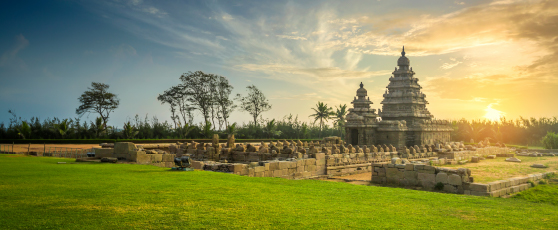
Poised gracefully along the Coromandel Coast of the Bay of Bengal, Mahabalipuram stands as a glorious ode to India’s cultural and architectural legacy. This temple town has metamorphosed into a regal retreat, extending an invitation to those yearning to immerse themselves in its spellbinding history.
Mamallapuram, also called Mahabalipuram, is linked to the story of a powerful demon king named Mahabali. The town’s name reflects its connection to both historical events, like the Pallava dynasty, and mythological tales, such as the legend of Mahabali. According to Hindu lore, Mahabali’s descent into the abyssal realms was precipitated by Lord Vishnu’s incarnation as the diminutive Brahmin, Vamana. Legend has it that King Narasimhavarman I, a luminary of the Pallava dynasty, orchestrated the construction of Mahabalipuram in the 7th century AD, etching this celestial episode in the sands of temporal antiquity.
The Shore Temple:
Nestled upon the shores of the Bay of Bengal, the Shore Temple emerges as a paragon of allure in Mahabalipuram, adorned by a backdrop of unparalleled grandeur. Crafted by the Pallavas in the 7th century, this temple unfolds the tapestry of Dravidian architectural brilliance, with intricate carvings narrating sagas from Hindu mythology, such as the Ramayana and Mahabharata. It stands as an indomitable testament to the architectural virtuosity of the Pallava dynasty, beckoning discerning global sojourners.
The Five Rathas:
The Five Rathas, colloquially hailed as the Pandava Rathas, stand as a symphony of architectural marvels in Mahabalipuram. Hewn from singular granite monoliths, these structures unveil the virtuosity of ancient Indian artisans, offering a panoramic view into the labyrinth of South Indian temple architecture. A homage to various deities and eponymously named after characters from the Mahabharata, the Five Rathas present an enthralling kaleidoscope of architectural styles, providing a lofty portal into the cultural mosaic of the region.
Arjuna's Penance:
Termed the “Descent of the Ganges,” Arjuna’s Penance transmogrified into an imposing bas-relief sculpture, an integral facet of the UNESCO World Heritage Site in Mahabalipuram. Immortalised onto the colossal boulders, this 7th-century masterpiece unfolds the visual narrative of the Mahabharata, encapsulating the sacred descent of the Ganges River. A magnum opus of ancient Indian rock-cut art, it stands as an eloquent testament to the artistic and cultural zenith of its epoch.
Krishna's Butter Ball:
Enthroned in Mahabalipuram, Krishna’s Butter Ball assumes the mantle of a geological spectacle, captivating onlookers with its ethereal semblance. This gargantuan granite boulder, seemingly defying the laws of gravity, maintains its steadfast perch on an incline. A namesake homage to Lord Krishna and entwined with the Hindu mythos of his childhood butter pilferage, it symbolises not only a geological marvel but also an emblem of the town’s cultural scene.
The Varaha Temple:
The Varaha temple is carved with meticulous finesse from a solitary monolithic rock and stands as the apotheosis of Pallava rock-cut architecture. This subterranean sanctuary from the 7th century venerates Lord Vishnu in his Varaha incarnation. Its walls bear witness to exquisitely detailed carvings, chronicling an intricate tapestry of deities and mythological vignettes.
As one embarks upon a vacation through this historical reverie, the discerning wayfarer discovers solace and sumptuousness at Kaldan Samudhra Palace. Just 2 km away from the resplendence of Mahabalipuram, the resort orchestrates an unparalleled symphony of regality and luxury, offering guests an immersive experience amidst the town’s cultural tapestry. Kaldan Samudhra Palace seamlessly intertwines with Mahabalipuram’s historical ethos, providing an idyllic sanctuary for those seeking the splendors of luxury and discovery in this hallowed destination.
For bookings & reservations, visit our website www.kaldanhotels.com or call us on +91 89258 14910.